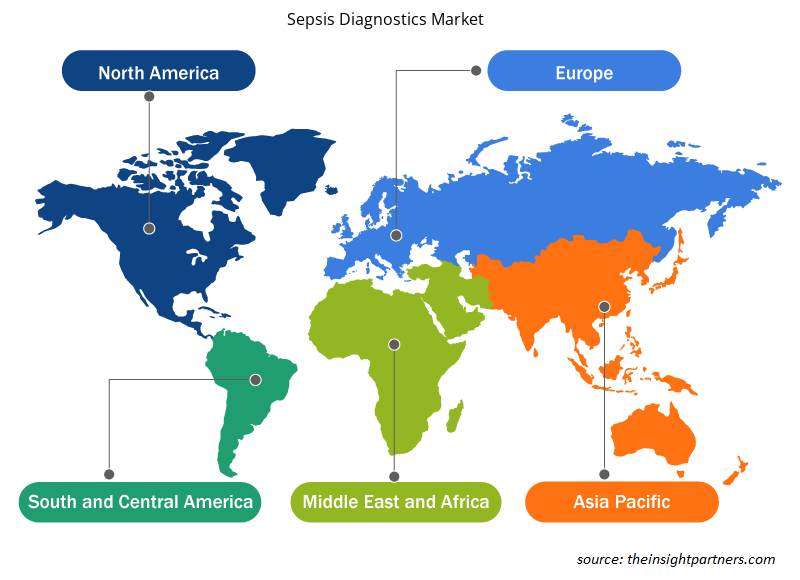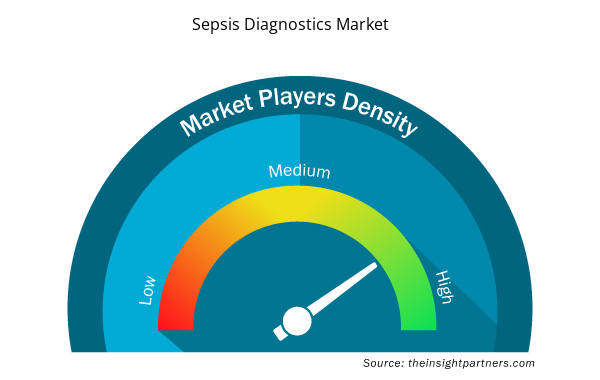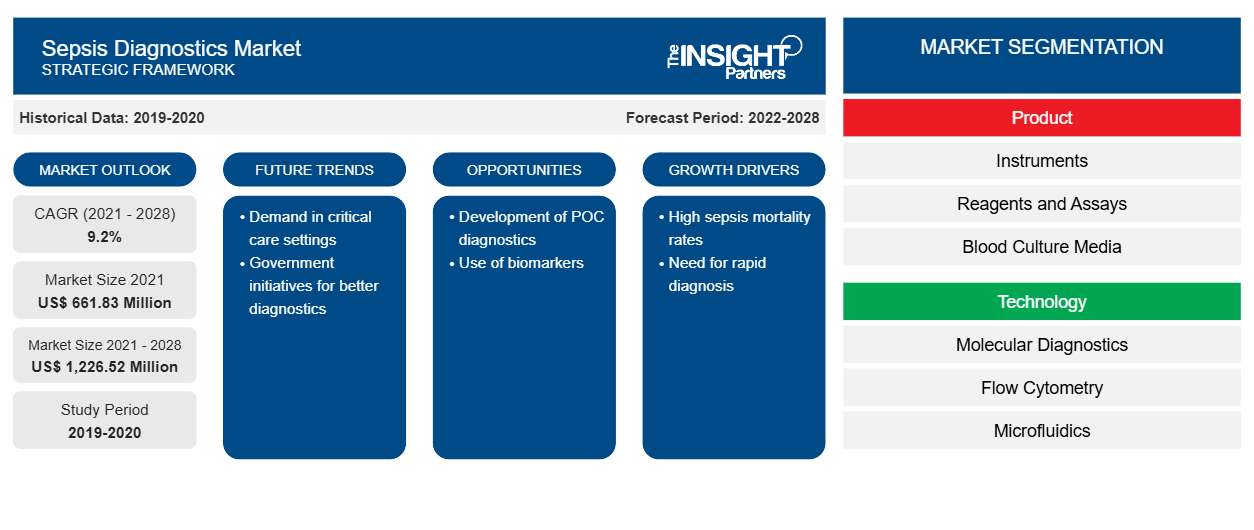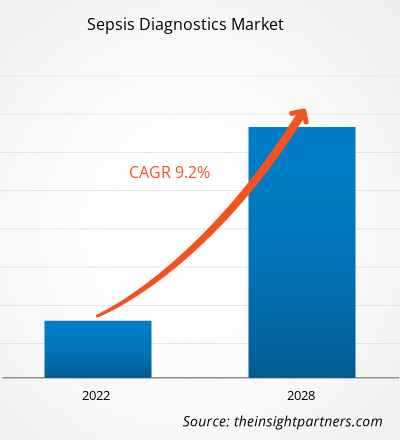败血症诊断市场规模预计将从 2021 年的 6.6183 亿美元增至 2028 年的 12.2652 亿美元;预计 2021 年至 2028 年的复合年增长率为 9.2%。
由于院内感染增加导致败血症发病率激增,以及对快速诊断测试的需求增加导致产品上市增加等因素推动了败血症诊断市场的增长。
败血症是一种严重且危及生命的临床疾病,通常由原发性细菌感染引起,或由真菌和/或病毒感染引起(但较少见)。败血症分为三个阶段:败血症、严重败血症和败血性休克的最后阶段。败血症诊断学是研究这种疾病的诊断。
在预测期内,北美很可能在败血症诊断市场占据主导地位。2021 年,美国占据了北美市场的最大份额,预计在预测期内将继续保持这一趋势。败血症影响了医院中大量患者,是住院的第六大常见原因。败血症患病率的增加和败血症诊断研发投资的激增预计将加速该地区败血症诊断市场的增长。此外,大型医疗保健市场参与者的存在导致败血症诊断产品发布量不断增加。
定制此报告以满足您的需求
您可以免费定制任何报告,包括本报告的部分内容、国家级分析、Excel 数据包,以及为初创企业和大学提供优惠和折扣
- 获取此报告的关键市场趋势。这个免费样品将包括数据分析,从市场趋势到估计和预测。
败血症诊断市场根据产品、技术、方法、检测类型、病原体、最终用户和地域进行细分。按地域划分,市场大致分为北美、欧洲、亚太地区、中东和非洲以及南美和中美洲。败血症诊断报告提供了对市场的见解和深入分析,强调了市场趋势、技术进步、市场动态和全球领先市场参与者的竞争分析等参数。
市场洞察
院内感染增多导致败血症发病率高
脓毒症主要发生在免疫功能低下的人群中,例如接受化疗、脾切除术以及患有艾滋病和糖尿病等慢性疾病的人。医院内感染,也称为院内感染,是住院患者发病和死亡的主要原因。根据美国疾病控制和预防中心 (CDC) 于 2021 年发布的《2020 年全国和各州医疗保健相关感染进展报告》,2019 年至 2020 年期间,美国中心静脉导管相关血流感染、呼吸机相关事件和耐甲氧西林金黄色葡萄球菌 (MRSA) 菌血症分别增加了约 24%、35% 和 15%。因此,血流感染的增加将增加脓毒症诊断产品的采用。
2020 年 9 月,世界卫生组织 (WHO) 估计,每年近 50% 的败血症病例发生在儿童中,每年有 290 万儿童死亡。大多数死亡可以通过早期诊断和适当的临床管理来预防。因此,败血症的高发病率推动了对败血症诊断产品的需求,从而支持了败血症诊断市场的增长。
产品洞察
根据产品,全球败血症诊断市场细分为仪器、试剂和测定、血培养基和软件。2021 年,血培养基部分占据了最大的市场份额。根据《临床微生物学家学会杂志》的报告,血培养基仍然是败血症管理中最关键的研究之一,因为它可以识别败血症的致病菌,适当选择经验性和特异性抗生素,并指向进一步的研究以确定感染的焦点。建议所有败血症患者使用血培养基。然而,预计软件部分将在预测期内实现市场上最高的复合年增长率。
技术洞察
根据技术,全球败血症诊断市场细分为分子诊断、流式细胞术、微流体技术、免疫测定、生物标志物和微生物学。2021 年,微生物学领域占据了最大的市场份额。快速而具体的病原体鉴定对于败血症治疗非常重要,微生物技术是败血症病原体鉴定的黄金标准,可以通过血液培养、继而进行亚培养,并通过生化或显微镜方法进行病原体鉴定。然而,在预测期内,分子诊断领域预计将在市场上实现最高的复合年增长率。
方法见解
根据方法,全球败血症诊断市场分为自动诊断和常规诊断。2021 年,常规诊断部分占据了更大的市场份额。然而,预计在预测期内,自动诊断部分将在市场上实现更高的复合年增长率。败血症的常规诊断程序需要几天时间。因此,与自动诊断相比,传统诊断方法的采用速度较慢。此外,公司专注于开发基于先进技术的自动诊断,例如用于检测败血症的分子诊断。
测试类型洞察
根据检测类型,全球败血症诊断市场分为即时检测和实验室检测。2021 年,实验室检测部分占据了更大的市场份额。然而,在预测期内,即时检测部分预计将在市场上实现更高的复合年增长率。POC 平台可以通过提供可访问且价格合理的临床信息来在更早的阶段检测败血症,从而简化诊断过程的需求,从而及时干预并采取适当的治疗方法。
病原体洞察
根据病原体,全球败血症诊断市场分为细菌败血症、真菌败血症和其他。2021 年,细菌败血症细分市场占有最大的市场份额。此外,预计同一细分市场在预测期内将实现最高的复合年增长率。
最终用户洞察
根据最终用户,全球败血症诊断市场分为医院、病理学和参考实验室以及其他。 2021 年,医院部门占据了最大的市场份额。 然而,病理学和参考实验室部门预计将在预测期内实现市场最高复合年增长率。
产品发布和合作是全球败血症诊断市场参与者广泛采用的策略,以扩大其全球足迹和产品组合。参与者还专注于合作战略以扩大客户群,这反过来又使他们能够在全球范围内保持自己的品牌名称。他们的目标是通过开发创新产品来扩大市场份额。以下列出了一些最近的关键市场发展:
- 2021 年 11 月,T2 Biosystems, Inc. 在台湾签署了区域独家分销协议。根据协议条款,T2 Biosystems 将通过其分销商销售 T2Dx 仪器以及 T2Bacteria、T2Candida 和 T2Resistance Panel。T2 Biosystems 及其新的分销合作伙伴与台湾卫生部门合作,以获得监管部门的批准,并为患者提供最高质量的败血症护理。
- 2019 年 5 月,丹纳赫子公司贝克曼库尔特推出了 Access PCT 检测。Access PCT 检测具有一流的灵敏度和低端精度,再加上较短的孵育时间,可帮助医生对有发展为严重脓毒症或脓毒症休克危险的危重患者进行风险评估,检测结果可在 20 分钟内获得。新的 Access PCT 检测获得了 CE 标志认证,可用于 Access 系列免疫检测系统,包括 Access 2、UniCel DxI 600 和 UniCel DxI 800。
败血症诊断市场区域洞察
Insight Partners 的分析师已详细解释了预测期内影响败血症诊断市场的区域趋势和因素。本节还讨论了北美、欧洲、亚太地区、中东和非洲以及南美和中美洲的败血症诊断市场细分和地理位置。

- 获取败血症诊断市场的区域特定数据
败血症诊断市场报告范围
| 报告属性 | 细节 |
|---|---|
| 2021 年市场规模 | 6.6183亿美元 |
| 2028 年市场规模 | 12.2652亿美元 |
| 全球复合年增长率(2021 - 2028) | 9.2% |
| 史料 | 2019-2020 |
| 预测期 | 2022-2028 |
| 涵盖的领域 | 按产品
|
| 覆盖地区和国家 | 北美
|
| 市场领导者和主要公司简介 |
|
败血症诊断市场参与者密度:了解其对业务动态的影响
败血症诊断市场正在快速增长,这得益于终端用户需求的不断增长,而这些需求又源于消费者偏好的不断变化、技术进步以及对产品优势的认识不断提高等因素。随着需求的增加,企业正在扩大其产品范围,进行创新以满足消费者的需求,并利用新兴趋势,从而进一步推动市场增长。
市场参与者密度是指在特定市场或行业内运营的企业或公司的分布情况。它表明相对于给定市场空间的规模或总市场价值,有多少竞争对手(市场参与者)存在于该市场空间中。
在败血症诊断市场运营的主要公司有:
- 雅培
- F.霍夫曼-罗氏有限公司
- Immunexpress 公司
- 屋宇署
- 丹纳赫
免责声明:上面列出的公司没有按照任何特定顺序排列。

- 了解败血症诊断市场的主要参与者概况
败血症诊断——市场细分
全球败血症诊断市场根据产品、技术、方法、测试类型、病原体和最终用户进行细分。在产品方面,全球败血症诊断市场细分为仪器、试剂和测定、血培养基和软件。基于技术,败血症诊断市场细分为分子诊断、流式细胞术、微流体、免疫测定、生物标志物和微生物学。在方法方面,市场细分为自动化诊断和常规诊断。根据测试类型,全球败血症诊断市场细分为即时诊断和实验室测试。在病原体方面,市场细分为细菌性败血症、真菌性败血症和其他。在最终用户方面,败血症诊断市场细分为医院、病理学和参考实验室等。
公司简介
- 雅培
- F.霍夫曼-拉罗氏有限公司
- Immunexpress 公司
- 屋宇署
- 丹纳赫
- Luminex 公司
- 赛默飞世尔科技公司
- 生物梅里埃公司
- T2 生物系统公司
- Axis-Shield Diagnostics 有限公司
- 历史分析(2 年)、基准年、预测(7 年)及复合年增长率
- PEST 和 SWOT 分析
- 市场规模价值/数量 - 全球、区域、国家
- 行业和竞争格局
- Excel 数据集


- Battery Testing Equipment Market
- Dealer Management System Market
- Transdermal Drug Delivery System Market
- Radiopharmaceuticals Market
- Grant Management Software Market
- Mail Order Pharmacy Market
- Sexual Wellness Market
- Joint Pain Injection Market
- Cosmetic Bioactive Ingredients Market
- Malaria Treatment Market

Report Coverage
Revenue forecast, Company Analysis, Industry landscape, Growth factors, and Trends

Segment Covered
This text is related
to segments covered.

Regional Scope
North America, Europe, Asia Pacific, Middle East & Africa, South & Central America

Country Scope
This text is related
to country scope.
常见问题
The sepsis diagnostics market majorly consists of the players, such as Abbott; F. Hoffman-La Roche Ltd; Immunexpress Inc.; BD; Danaher (Beckman Coulter); Luminex Corporation; Thermo Fischer Scientific Inc.; bioMerieux SA; T2 Biosystems, Inc.; Axis-Shield Diagnostics Ltd; among others.
The Centers for Disease Control and Prevention (CDC) defines sepsis as the body's extreme response to an infection. It is a life-threatening medical emergency. Sepsis can also be a result of other infections, including viral infections, such as COVID-19 or influenza. Early detection and specific clinical intervention has revealed to be crucial for improving the outcome of patients suffering from sepsis.
The factors that are driving the growth of market are high incidence of sepsis due to nosocomial infections and the high demand for rapid diagnostic tests leading to increasing product launches. However, the lack of skilled professionals is the major factor hindering the sepsis diagnostics market growth.
The market is estimated to grow at a CAGR of 9.2% during the forecast period.
The sepsis diagnostics market is analyzed in the basis of product, technology, method, test type, pathogen, and end user. Based on technology, the market is segmented into molecular diagnostics, flow cytometry, microfluidics, immunoassay, biomarkers, and microbiology. The microbiology segment held the largest share of the market. However, the molecular diagnostics segment is anticipated to register the highest CAGR.
The sepsis diagnostics market is expected to be valued at US$ 1,226.52 million in 2028
The sepsis diagnostics market is estimated to be valued at US$ 661.83 million in 2021.
North America accounts for the major market share of sepsis diagnostics market in 2021 owing to rising number of product launches and approvals.
Asia Pacific is expected to be the fastest growing region in sepsis diagnostics market over the forecast period.
Trends and growth analysis reports related to Life Sciences : READ MORE..
The List of Companies - Sepsis Diagnostics Market
- Abbott
- F. Hoffmann-La Roche Ltd.
- Immunexpress Inc.
- BD
- Danaher
- Luminex Corporation
- Thermo Fisher Scientific Inc.
- bioMerieux SA.
- T2 Biosystems, Inc.
- Axis-Shield Diagnostics Ltd.
The Insight Partners performs research in 4 major stages: Data Collection & Secondary Research, Primary Research, Data Analysis and Data Triangulation & Final Review.
- Data Collection and Secondary Research:
As a market research and consulting firm operating from a decade, we have published and advised several client across the globe. First step for any study will start with an assessment of currently available data and insights from existing reports. Further, historical and current market information is collected from Investor Presentations, Annual Reports, SEC Filings, etc., and other information related to company’s performance and market positioning are gathered from Paid Databases (Factiva, Hoovers, and Reuters) and various other publications available in public domain.
Several associations trade associates, technical forums, institutes, societies and organization are accessed to gain technical as well as market related insights through their publications such as research papers, blogs and press releases related to the studies are referred to get cues about the market. Further, white papers, journals, magazines, and other news articles published in last 3 years are scrutinized and analyzed to understand the current market trends.
- Primary Research:
The primarily interview analysis comprise of data obtained from industry participants interview and answers to survey questions gathered by in-house primary team.
For primary research, interviews are conducted with industry experts/CEOs/Marketing Managers/VPs/Subject Matter Experts from both demand and supply side to get a 360-degree view of the market. The primary team conducts several interviews based on the complexity of the markets to understand the various market trends and dynamics which makes research more credible and precise.
A typical research interview fulfils the following functions:
- Provides first-hand information on the market size, market trends, growth trends, competitive landscape, and outlook
- Validates and strengthens in-house secondary research findings
- Develops the analysis team’s expertise and market understanding
Primary research involves email interactions and telephone interviews for each market, category, segment, and sub-segment across geographies. The participants who typically take part in such a process include, but are not limited to:
- Industry participants: VPs, business development managers, market intelligence managers and national sales managers
- Outside experts: Valuation experts, research analysts and key opinion leaders specializing in the electronics and semiconductor industry.
Below is the breakup of our primary respondents by company, designation, and region:

Once we receive the confirmation from primary research sources or primary respondents, we finalize the base year market estimation and forecast the data as per the macroeconomic and microeconomic factors assessed during data collection.
- Data Analysis:
Once data is validated through both secondary as well as primary respondents, we finalize the market estimations by hypothesis formulation and factor analysis at regional and country level.
- Macro-Economic Factor Analysis:
We analyse macroeconomic indicators such the gross domestic product (GDP), increase in the demand for goods and services across industries, technological advancement, regional economic growth, governmental policies, the influence of COVID-19, PEST analysis, and other aspects. This analysis aids in setting benchmarks for various nations/regions and approximating market splits. Additionally, the general trend of the aforementioned components aid in determining the market's development possibilities.
- Country Level Data:
Various factors that are especially aligned to the country are taken into account to determine the market size for a certain area and country, including the presence of vendors, such as headquarters and offices, the country's GDP, demand patterns, and industry growth. To comprehend the market dynamics for the nation, a number of growth variables, inhibitors, application areas, and current market trends are researched. The aforementioned elements aid in determining the country's overall market's growth potential.
- Company Profile:
The “Table of Contents” is formulated by listing and analyzing more than 25 - 30 companies operating in the market ecosystem across geographies. However, we profile only 10 companies as a standard practice in our syndicate reports. These 10 companies comprise leading, emerging, and regional players. Nonetheless, our analysis is not restricted to the 10 listed companies, we also analyze other companies present in the market to develop a holistic view and understand the prevailing trends. The “Company Profiles” section in the report covers key facts, business description, products & services, financial information, SWOT analysis, and key developments. The financial information presented is extracted from the annual reports and official documents of the publicly listed companies. Upon collecting the information for the sections of respective companies, we verify them via various primary sources and then compile the data in respective company profiles. The company level information helps us in deriving the base number as well as in forecasting the market size.
- Developing Base Number:
Aggregation of sales statistics (2020-2022) and macro-economic factor, and other secondary and primary research insights are utilized to arrive at base number and related market shares for 2022. The data gaps are identified in this step and relevant market data is analyzed, collected from paid primary interviews or databases. On finalizing the base year market size, forecasts are developed on the basis of macro-economic, industry and market growth factors and company level analysis.
- Data Triangulation and Final Review:
The market findings and base year market size calculations are validated from supply as well as demand side. Demand side validations are based on macro-economic factor analysis and benchmarks for respective regions and countries. In case of supply side validations, revenues of major companies are estimated (in case not available) based on industry benchmark, approximate number of employees, product portfolio, and primary interviews revenues are gathered. Further revenue from target product/service segment is assessed to avoid overshooting of market statistics. In case of heavy deviations between supply and demand side values, all thes steps are repeated to achieve synchronization.
We follow an iterative model, wherein we share our research findings with Subject Matter Experts (SME’s) and Key Opinion Leaders (KOLs) until consensus view of the market is not formulated – this model negates any drastic deviation in the opinions of experts. Only validated and universally acceptable research findings are quoted in our reports.
We have important check points that we use to validate our research findings – which we call – data triangulation, where we validate the information, we generate from secondary sources with primary interviews and then we re-validate with our internal data bases and Subject matter experts. This comprehensive model enables us to deliver high quality, reliable data in shortest possible time.


 获取此报告的免费样本
获取此报告的免费样本